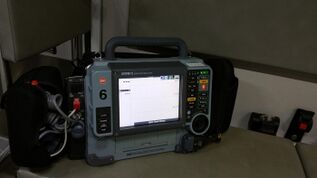Medicine:Lifepak
Lifepak (stylized LIFEPAK) is a series of vital signs monitors and external cardiac defibrillators produced by medical technology company Physio-Control.[1][2][3][4]
In 2020 the company recalled some of its defibrillators after it learned they may fail in some circumstances, however the issues have been addressed.[5][6]
History
Physio-Control publicly demonstrated its first Lifepak branded defibrillator, Lifepak 33, in November 1968 and began commercial sale of the unit the next year in 1969.[7][8] The Lifepak 33 was the lightest defibrillator available at launch, weighing 34 pounds. The defibrillator was referred to by media as a "90-day wonder" due to the entirety of its development occurring within a 90-day period. Despite being the companies first "LIFEPAK" branded defibrillator, it was named the Lifepak 33 due to the companies target weight of 33 pounds for the defibrillator.[9]
In 1971, the Lifepak 911 was released with 12-lead ECG monitoring capability, with the Lifepak 2 being released the following year. The Lifepak 2 was designed specifically for rapid-response vehicles in emergency services, and was the first to allow transmission of ECGs via telephone to hospitals for prehospital assessment by cardiologists. In 1973, the Lifepak 3 was released with a "non-fade" display and the ability to "freeze" the cardioscope. The Lifepak 1 was released the same year and was marketed as a more basic, but more compact model, lacking a cardiograph for ECG monitoring. In 1974, the Lifepak 4 was released with an integrated ECG recorder, and was followed by the Physio 260 (for home use) and Physio 1440 cardiac care system defibrillators were released to the public.[9]
In 1976, the Lifepak 5 was released weighing only 5 pounds and 19 ounces, with a modified Lifepak 5 accompanying the 65-member American Medical Expedition to Mount Everest in 1981 and the China-Everest Expedition in 1982. The Lifepak 6 featured a modular design with removable paddles holder and ECG printer, the Lifepak 8 featured the ability to perform transchest external pacing, and the Lifepak 100 and 200 automatic advisor defibrillators were released with an Incorporated Shock Advisory System able to recognise shockable arrhythmias. in 1989, the Lifepak 9 and 10 both integrated a "Code Summary" record for documentation, featuring the ability to record times medication was administered, when shocks were delivered and how many shocks were delivered.[9]
In 1994, the Lifepak 11 was released, which set standards in prehospital 12-lead acquisition and transmission. In 1997, the Lifepak 500 was released as a public access defibrillator, and brought AEDs to the mainstream public. The following year, the Lifepak 12 was released, with improved monitoring and diagnostic capabilities, as well as a standardised button layout. Some ambulance services still use the Lifepak 12 due to its reliability and advanced capabilities.[9]
The current model, Lifepak 15, was released in 2008 and featured a more refined design, new colour scheme as well as colour display, CPR metronome and Bluetooth connectivity for wireless transmission of ECGs.[10]
Semi-automatic units include the Lifepak 12, Lifepak 15, and Lifepak 20 for use by healthcare professionals such as emergency medical technicians and paramedics. Automatic units include the Lifepak 500, Lifepak 1000, Lifepak CR Plus and the Lifepak CR2 for use by members of the public who have been trained to operate them.[11]
Usage
Most Lifepak defibrillators are capable of performing more than only defibrillation. Many models allow for cardiac monitoring (including heart rate monitoring and 12-Lead ECG acquisition and interpretation) and alert the users to sudden changes. The Lifepak 15 and 20e (when equipped with CodeManagement Module) include a CPR metronome that is also capable of verbally aiding rescuers in providing ventilations. Some Lifepak defibrillators also include options for synchronized cardioversion, external pacing, oxygen saturation monitoring, CO2 output monitoring, and both non-invasive and invasive blood pressure.[12] The Lifepak CR2 includes CPRInsight analysis technology which allows for chest compression during analysis of the patient's ECG.[13]
See also
- Ambulance
- Medical device
- Physio-Control
- Defibrillation
- Cardioversion
- Electrocardiography
References
- ↑ "New Lifepak will save lives at Port Moody hospital" (in en). https://www.tricitynews.com/local-news/new-lifepak-will-save-lives-at-port-moody-hospital-3053583.
- ↑ Thomas, Erica. "VIDEO: Argo Fire & Rescue gets $115k worth of life-saving equipment" (in en-US). https://www.trussvilletribune.com/2021/07/15/video-argo-fire-rescue-gets-115k-worth-of-life-saving-equipment/.
- ↑ "These 10 medtech companies put a lot into research | Page 4 of 11" (in en-US). 2020-12-04. http://www.medicaldesignandoutsourcing.com/these-10-medtech-companies-care-a-lot-about-research/.
- ↑ Johnson, Tim. "A life-saving addition: Lincoln County law enforcement have 1st training with new AEDs" (in en). https://nptelegraph.com/news/local/a-life-saving-addition-lincoln-county-law-enforcement-have-1st-training-with-new-aeds/article_3802c22c-c993-11eb-8806-c70d0e733541.html.
- ↑ "LifePAK 15 Defibrillators Might Fail After Shock Button is Pressed" (in en). 2020-01-13. https://www.dicardiology.com/content/lifepak-15-defibrillators-might-fail-after-shock-button-pressed.
- ↑ Garcia, Jon. "Stryker announces voluntary field action on LIFEPAK 15 defibrillators" (in en-US). https://www.tennessean.com/story/news/2019/02/04/stryker-medical-lifepak-voluntary-monitor-defibrillator/2772768002/.
- ↑ "1968: LifePak33". February 2008. https://emsmuseum.org/collections/archives/defibrillators/1968-lifepak33/.
- ↑ "Physio-Control International Corp.". https://www.encyclopedia.com/books/politics-and-business-magazines/physio-control-international-corp.
- ↑ 9.0 9.1 9.2 9.3 "LifePak Series from Physio-Control" (in en-US). https://emsmuseum.org/collections/archives/defibrillators/lifepak/.
- ↑ "LIFEPAK 15 monitor/defibrillator" (in en). https://www.stryker.com/gb/en/emergency-care/products/lifepak-15/index-eu-eemea.html.
- ↑ "Physio-Control Lifepak". Physio-Control, Inc. Archived from the original on 2011-07-15. https://web.archive.org/web/20110715082927/http://www.physio-control.com/about/.
- ↑ AED kopen
- ↑ "LIFEPAK CR2 AED" (in en). https://www.strykeremergencycare.com/products/devices/lifepak-cr2/.
 |


